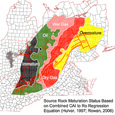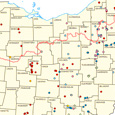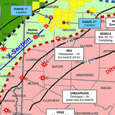Natural gas industry may spur job growth in the state of Pennsylvania
Saturday, July 11, 2009
WILLIAMSPORT, Pa. — The developing natural gas industry in Pennsylvania will create jobs and offer opportunities for local residents. At least that’s what a recently report by the Marcellus Shale Workforce Needs Assessment says.
The report suggests that, depending on the intensity of development, between 1,292 and 2,153 direct, full-time jobs could be required in the Northern Tier (Bradford, Sullivan, Susquehanna, Tioga and Wyoming counties) this year to support well drilling and production. The number of jobs is expected to grow to between 2,107 and 3,511 by 2011 and to between 3,281 and 5,468 by 2013.
In the Central Region (Centre, Clinton, Columbia, Lycoming, Mifflin, Montour, Northumberland, Snyder and Union counties), between 325 and 542 direct, full-time jobs are projected in 2009; that number is expected to increase to between 1,347 and 2,245 in 2011-13 as drilling intensifies in this region.
Job creation. In addition to these direct-employment projections, the Pennsylvania Economy League recently estimated that each direct job in the Pennsylvania oil and gas industry creates an additional one and half indirect jobs throughout the economy.
Because most companies and workers have not yet located in the region, a challenge of the study was determining where companies might base their operations.
Natural gas industry companies are known for commuting long distances and quickly changing the locations of offices, yards and staging areas. It is not yet known how far workers will be willing to travel to work in the Northern Tier and Central Region, but early in the development stage, several areas emerged with the greatest potential to host many of the major companies and workers.
Permits issued. As of this month, 435 permits were issued in the Northern Tier and 123 in the Central Region. Projections suggest that, in the most likely scenario, the number of wells drilled per year will rise to 356 in the Northern Tier and 146 in the Central Region by 2013.
High and low projections for the regions range between 267 and 445 in the Northern Tier and between 110 and 183 in the Central Region. The MSETC workforce projection model suggests that approximately 410 individuals in 150 different occupations are required to develop and drill a single well in the Marcellus Shale.
The total of number of hours worked by these individuals on a single well is the equivalent of 11.5 full-time jobs over the course of the year. The actual workforce needed will fluctuate during the drilling stage, depending upon how many wells are drilled per year, the report states. Ninety-eight percent of the jobs are required only until the well is completed; these do not continue into the production phase, which requires fewer, but more long-term positions.
Employees needed. The industry will not meet all its needs with local workers. The report goes on to describe how the nature of the industry creates unique workforce requirements.
The movement of temporary workers through the area creates opportunities for businesses that service the workers’ needs (hotels, motels, campgrounds, restaurants, etc.) and also may create interest among local residents who want to pursue the travel opportunities and financial rewards of the industry.
The needs assessment found that 75 percent of the natural gas industry’s workforce comprises jobs that require experience-driven skills and knowledge specific to the natural gas industry. Most of these positions do not require formal postsecondary education; some do require trade certifications. Those who want to seek advancement in the industry will benefit from more advanced education.
Occupations involved with the development of the natural gas industry represent a wide range of career opportunities — from welders, heavy equipment operators, commercial drivers and loggers to X-ray technicians, geologists, engineers, inspectors, supervisors, office workers, paralegals and lawyers.
Many of the employment opportunitieswill be with service businesses that work directly with the natural gas companies and with existing businesses that will benefit from more dollars circulating in the economy.
As new companies move into the region it is expected that they will look for local workers to fill their needs. Assessment completed. The needs assessment was conducted by the Marcellus Shale Education & Training Center, a partnership between Pennsylvania College of Technology and Penn State Cooperative Extension, with additional funding from the Pennsylvania Department of Labor and Industry provided through the Central Pennsylvania Workforce Development Corp. and the Northern Tier Regional Planning and Development Commission.




